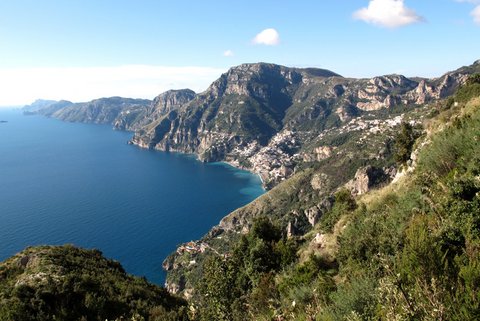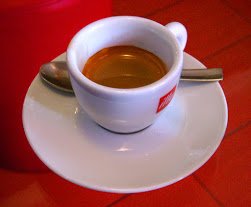T
he Amalfi Coast shimmers in the distance, a magical string of jewel-like towns—Amalfi, Ravello, Positano—glittering with romance, history, and sybaritic beauty. Pastel-colored houses cling to the cliffs like oversized swallows' nests; groves of lemon trees perfume the landscape. It’s no wonder the Amalfi attracted the Roman Emperor Tiberius, Richard Wagner, Sophia Loren and countless travelers like us.
Despite its beauty, or perhaps because of it, the Amalfi is supposed to be one of the most challenging drives in Italy, a gauntlet of hairpin turns, narrow roads, and rickety guardrails over steep limestone cliffs. The narrow, two-lane track can be overrun with cars, tour buses, motorcycles, bicyclists, pedestrians, gawking tourists, and distracted fruit vendors. All the travel books advise against driving it, recommending a bus instead.
But how bad can it be? It’s just another road and an incredibly scenic one at that. It’s forty miles from Salerno to Nerano, the small fishing village where we plan to stay. I’ve driven in Italy before and it can be thrilling—if it doesn’t kill.
My navigator, Chris Olsen, gives me the thumbs up. He’s reliving his wayward youth as an exchange student in Italy. Friends since high school, we are on a two-week trip to Italy, the first part of which includes three days on the Amalfi Coast, a place I’d long wanted to visit for its sea vistas, hiking trails and languorous
dolce vita.
I rev the engine of our black Fiat Punto and point it north. The car looks as crushable as a pop can, but it’s small and peppy, important attributes on a road like this one.
The road winds its way around the first point. Cars accelerate, crossing the center line on the curves. I respect the median, careful to stay in the right lane.
HONK! In the rearview mirror, I spot an Italian man gesticulating wildly at me to speed up.
I step on the gas, blowing past the Marina de Vietri, a lovely port on the Mediterranean. Taking in the sailboats bobbing at anchor, I nearly sideswipe a motorcyclist who blurs past me on a blind corner, leaving a trail of exhaust in his wake.
Italians may be known for their slow-paced quality of life, but that doesn’t apply to driving; everyone seems to be main-lining espresso.
Vino? Amore? La dolce vita? Non! Andiamo!
A man on a scooter drafts behind me. When I ease up on the accelerator, he shoots by, his girlfriend holding on to him with one hand and eating a gelato with the other.
“Mario,” Chris says.
“Andiamo!”
“Mario?”
“As in Andretti,” he says.
Is he mocking me or egging me on? I honk the horn at a passing motorcyclist but it comes out as a squeak.
The town of Ravello glitters ahead, the whitewashed houses looking like the top of a wedding cake. I drink in the view, wanting to disappear into the postcard. Mistake!
A car screams around the bend from the other direction, crossing the center line and clipping my side mirror.
My jet lag explodes in a hot blast of fear. My shirt damp with sweat, my feet cramping, I grip the steering wheel, ignoring the lemon groves sailing by.
When we reach the lovely resort town of Amalfi, I pull over to take a break. I emerge from the car shaking like a bowl of Jell-O. Peach-colored villas overlook a white-pebbled beach and a small harbor dotted with umbrellas. We find an outdoor table on the main square and order a salad, taking a moment to savor the smell of salt air and jasmine on the breeze. Feeling another wave of jet lag wash over me, I pound the espresso. I don’t want to lose my edge. Chris has a glass of wine; he’s on vacation.
“
Andiamo!” he says after I pay the bill. He’s ready to practice his Italian gestures again.
Buzzing from the espresso, I rejoin the pack, swerving back and forth through the traffic, honking constantly, nearly running over a lemon vendor who steps into the road. He retreats deftly, avoiding making lemonade.
“
Subito!” Chris says, wanting to go even faster. He’s becoming a tyrant.
The asphalt slaloms around a point overgrown with purple Jupiter’s Beard. I want to look, but I don’t dare. The pack hurtles along—any slacking off is met by furious honking. Another car passes me, nearly taking out a bicyclist.
“
Que cosa fai?” Chris shakes his hand at the offending driver.
A motorcyclist whizzes past in full leathers with a bulbous, insect-like helmet, leaving us in his big, fat carbon footprint.
I lay on the horn. Chris provides the appropriate gesture, bringing his right fist under his left arm. A low point for Italian-American relations? No one seems to notice.
Andiamo!
Perspiration trickles down my forehead. I lean forward in the seat. I’m getting into it now. I came here for rest and relaxation, but in a sick way, I’m starting to enjoy the driving. Beautiful sea vistas? Grape vines carpeting green hillsides? Forget it! I just want to keep my place in the pack.
Ahead, I spot the hip resort town of Positano. It was a sleepy fishing village when John Steinbeck stayed here in the early 1950s, a lazy forgotten place, far from the madding crowds of tourists. Now it’s mobbed with people, cars, and traffic, a gauntlet of cantilevered garages, hotels, and villas clinging to the vertical terrain.
Below the town, I spot a group of young women sunbathing on the beach, their nubile bodies slathered with tanning oil, a vision of calm, peace, tranquility. They seem impossibly far below me. Are they modern versions of the Sirens who sang to Odysseus? It’s a good thing he didn’t drive the coast. He may never have returned home.
Distracted by the sunbathers, I careen around a corner, drifting into the other lane. A tour bus looms up in front of us like a monster in a science fiction movie, threatening to crush us like a bug against its giant windshield.
“Watch out!” Chris yells.
I veer to the right, but a biker wobbles into the road. Laying on the horn, I create a seam between biker and tour bus. We shoot through the gap, the massive bus mirror clipping our side mirror. Wham!
“
Andiamo,” he says, looking pleased.
Is he crazy or drunk?
By the time we reach Nerano, a gallon of sweat and several lifetimes later, I’m exhausted but exhilarated. We’ve survived the drive!
Our hotel couldn’t be more idyllic, with expensive views of the Mediterranean and groves of lemon trees, the bright yellow fruit hanging above the blue-tiled swimming pool. After three days of hiking, swimming, basking in the sun, I finally enter vacation mode. On our last night, I meet a young German who drove the Amalfi Coast, too. He laughs about the craziness of it and cautions that it's bad luck to have your side mirror hit more than three times. Ours was hit twice, but I don’t feel the need to push my luck.
We leave early the next morning, planning to head back through Sorrento to the auto route. But when we arrive at the turnoff, a policeman in mirrored sunglasses tells us the tunnel is blocked.
“How do we get to the auto route?”
“Take the Amalfi Coast,” he says.
This time, the road is jammed, which slows the pace and increases the frustration. When traffic backs up, people get out of their cars to smoke and argue with each other. I get a chance to watch ships lazily plying the Mediterranean 500 feet below. Exhaust mingles with scent of citrus; it smells like Italian cologne.
Finally, the traffic starts moving. The speed increases when we reach an open stretch. Ahead, a tour bus slows the traffic, earning a cacophony of honks. A blue van shoots out into the opposite lane, honks at an oncoming car, forcing it into the ditch, and passes the bus. The van driver slams on his brakes, stopping the bus and the rest of us behind it.
The van driver, a tall man in a straw hat, berates the bus driver for not pulling over, gesturing theatrically toward the cars behind. The bus driver argues, throws up his hands and allows the rest of us to proceed.
The race is on again! Cars fly around the turns, releasing the pent up frustration of the traffic jam. As much as I enjoyed Nerano, I relish being back behind the wheel. I admire
la dolce vita of Italy, but I love the triple espresso intensity of the driving, epitomized by the audacity of the van driver. How dare you slow us down?
Before rejoining the auto route, the road snakes around a point. A bus barges into our lane from the left. On the right, an old woman in a house dress and support hose lurches into the road. There’s not enough room for all of us.
I lay on the horn. The woman shuffles over, allowing us to dodge the bus, which clips our side mirror. The third time! I glance back to see her shake a shopping bag at us. Did I really just honk at an elderly woman? What am I becoming? Then it dawns on me: an Italian driver.
Andiamo!


